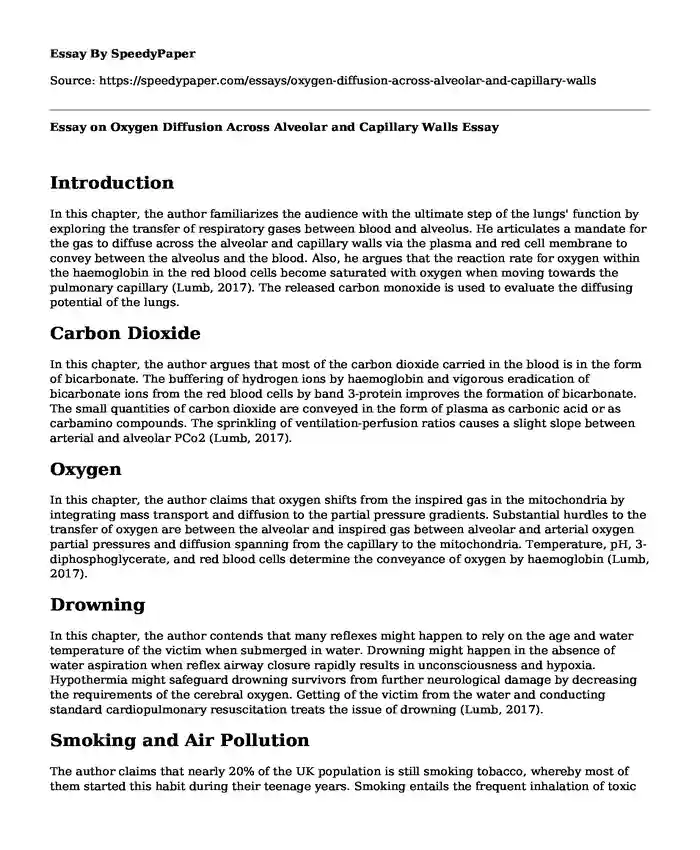
| Type of paper: | Essay |
| Categories: | Biology Science Healthcare |
| Pages: | 2 |
| Wordcount: | 428 words |
Introduction
In this chapter, the author familiarizes the audience with the ultimate step of the lungs' function by exploring the transfer of respiratory gases between blood and alveolus. He articulates a mandate for the gas to diffuse across the alveolar and capillary walls via the plasma and red cell membrane to convey between the alveolus and the blood. Also, he argues that the reaction rate for oxygen within the haemoglobin in the red blood cells become saturated with oxygen when moving towards the pulmonary capillary (Lumb, 2017). The released carbon monoxide is used to evaluate the diffusing potential of the lungs.
Carbon Dioxide
In this chapter, the author argues that most of the carbon dioxide carried in the blood is in the form of bicarbonate. The buffering of hydrogen ions by haemoglobin and vigorous eradication of bicarbonate ions from the red blood cells by band 3-protein improves the formation of bicarbonate. The small quantities of carbon dioxide are conveyed in the form of plasma as carbonic acid or as carbamino compounds. The sprinkling of ventilation-perfusion ratios causes a slight slope between arterial and alveolar PCo2 (Lumb, 2017).
Oxygen
In this chapter, the author claims that oxygen shifts from the inspired gas in the mitochondria by integrating mass transport and diffusion to the partial pressure gradients. Substantial hurdles to the transfer of oxygen are between the alveolar and inspired gas between alveolar and arterial oxygen partial pressures and diffusion spanning from the capillary to the mitochondria. Temperature, pH, 3-diphosphoglycerate, and red blood cells determine the conveyance of oxygen by haemoglobin (Lumb, 2017).
Drowning
In this chapter, the author contends that many reflexes might happen to rely on the age and water temperature of the victim when submerged in water. Drowning might happen in the absence of water aspiration when reflex airway closure rapidly results in unconsciousness and hypoxia. Hypothermia might safeguard drowning survivors from further neurological damage by decreasing the requirements of the cerebral oxygen. Getting of the victim from the water and conducting standard cardiopulmonary resuscitation treats the issue of drowning (Lumb, 2017).
Smoking and Air Pollution
The author claims that nearly 20% of the UK population is still smoking tobacco, whereby most of them started this habit during their teenage years. Smoking entails the frequent inhalation of toxic compounds that arouse the airway irritant receptors. The impacts of passive smoking start in utero when the development of the lungs is impaired. Air pollution can happen indoors or outdoors and is linked with many respiratory illness and symptoms (Lumb, 2017)
References
Lumb, A. B. (2017). Nunn's Applied Respiratory Physiology (8th ed.). Elsevier.
Cite this page
Essay on Oxygen Diffusion Across Alveolar and Capillary Walls. (2023, Nov 30). Retrieved from https://speedypaper.net/essays/oxygen-diffusion-across-alveolar-and-capillary-walls
Request Removal
If you are the original author of this essay and no longer wish to have it published on the SpeedyPaper website, please click below to request its removal:
- Paper Sample on the Misuse of Opiate Medication in Non-Cancer Patients
- Sulfonylureas and Meglitinides - Pharmacology Essay Example
- Essay Example on Tools for Implementing an Evidence-Based Approach
- Free Essay Example on Healthcare Reforms
- Free Essay: Sick Around the World Online Video Essay
- Essay Example: Homeland Security Response and Recovery Assignment
- Essay Sample on Why Fast Foods Should Be Outlawed
Popular categories




